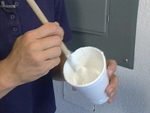This article will cover methods for fixing drywall, whether there are nail/screw holes, small dents, all the way up to larger holes.
Materials List
- Spackling Compound
- Putty Knife
- Sand Paper
- Touch-up Paint
Patching Nail or Screw Holes
Small nail/screw holes can be repaired pretty easily.
- Take your spackling compound and with a putty knife “paste” over the nail / screw holes.
- Make sure the compound is completely dry before you lightly sand over it. As you sand, rub you hand over the area to make sure it is level with the wall.
- Once the area is sanded, simply paint. When the paint is dry you will have a hard time guessing where the nail or screw used to be!
If your drywall is older, you may notice a few nails “popping” through the wall.
This means the nail is not holding properly and you will have to repair it.
Take a nail and hammer it to the stud directly above or below the popped nail.
Then hammer the popped nail back into place.
You will need to use your spackling compound again to fill the dents left by hammering the nails into the wall.
Once the compound is dry, sand and paint.
Patching Small Dents
If you want to repair a small dent, sand the surface thoroughly using coarse sandpaper and a sanding block.
You will end up with a rough surface that will bond better to the joint compound you will be using.
Fill the dent with a good grade of joint compound using a 3″ or 4″ spreader.
Spread the compound evenly, pressing it into the dent.
Larger dents may require a second coat applied after the first coat is completely dry.
After the joint compound has dried, sand the area smooth using fine sandpaper and a sanding block.
Sand just enough to remove high spots and blend the edges with the surrounding areas.
You must be careful not to sand so much that you create a low spot where your patch is.
Again, rub your hand over the patch frequently as you sand and stop when you can no longer feel any difference between the patch and surrounding wall.
If you are trying to repair a crack in your drywall, clean the crack area thoroughly by removing any loose material from the crack.
If there are any high spots, sand them down with coarse sandpaper before applying compound.
After the crack is clean, apply patching plaster with a wide, flexible putty knife.
Apply the compound in both directions across the crack pressing the compound firmly into the crack.
Then you will need to scrape off any excess material by running the knife along the length of the crack.
Once the compound has dried, sand it smooth and touch up any areas that may require it.
You may want to dip the putty knife in water to make the final pass.
Patching Larger Holes
Larger holes in drywall are not as easy to patch because there’s no backing material behind them.
You can build new backing however by taking a piece of cardboard, slightly larger than the hole, and tie a string through the middle of it.
Then insert the cardboard into the hole and pull the string tight.
While holding it tight, apply a first coat of patching compound to fill the hole.
Once it’s dry, cut the string and apply a second coat.
To help strengthen the patch you can apply some fiberglass tape to the seams and then tape over that.
Feather out the compound around the hole with a wide knife.
Let it dry and sand it smooth and repaint.
Here is another way you can patch larger holes, use plywood strips as the backer, cutting them longer than the hole, but narrow enough to go through the hole.
Then you will need to secure the strips by screwing into them through the drywall and use enough to provide backing for the entire hole.
Then finish the patch as we described above.
Another method is called the “hat patch.”
For this you will need to cut a piece of drywall the size of the hole, but let the paper on front run an inch or two longer.
The paper will serve as the joint tape.
Then insert the “hat” into the hole with some joint tape around the drywall.
Cover the patch with two coats of joint compound. Then sand it and prime over it.
Some General Quick Tips / Advice for Drywall Patching
Here’s a two-in-one quick tip you can use when patching holes in drywall.

Try mixing the spackling compound with matching leftover paint. This works well for small jobs, plus you won’t need to paint when the patchwork is dry.
If you’re out of the spackling compound, try this for small jobs, use white toothpaste to fill the holes.
Just make sure that your toothpaste is completely dry before you paint over it.
Thin coats of joint compound dry faster than heavy coats.
Thin coats are also easier to smooth.
Most joint compounds will shrink when drying so while your patch may seem flush with the surrounding wall when wet, it may produce a concave area when dry.
Build a slightly “high” patch with the joint compound and sand flush with surrounding area when dry.
Smoothing joint compound as much as possible when applying will minimize sanding.
Always wear a dust mask when sanding joint compound.

